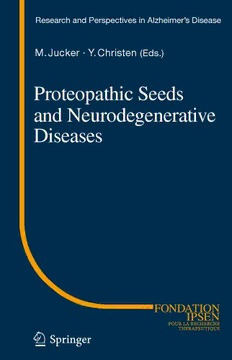
Proteopathic Seeds and Neurodegenerative Diseases PDF
Preview Proteopathic Seeds and Neurodegenerative Diseases
Research and Perspectives in Alzheimer’s Disease M. Jucker · Y. Christen (Eds.) Proteopathic Seeds and Neurodegenerative Diseases 123 Research and Perspectives in Alzheimer’s Disease For furthervolumes: http://www.springer.com/series/1175 . Mathias Jucker (cid:129) Yves Christen Editors Proteopathic Seeds and Neurodegenerative Diseases Editors MathiasJucker YvesChristen UniversityofTu¨bingen FondationIPSEN DepartmentofCellularNeurology Boulogne-BillancourtCedex HertieInstitutef.Clin.BrainResearch France Tu¨bingen,Germany ISSN0945-6066 ISBN978-3-642-35490-8 ISBN978-3-642-35491-5(eBook) DOI10.1007/978-3-642-35491-5 SpringerHeidelbergNewYorkDordrechtLondon LibraryofCongressControlNumber:2013935112 #Springer-VerlagBerlinHeidelberg2013 Thisworkissubjecttocopyright.AllrightsarereservedbythePublisher,whetherthewholeorpart of the material is concerned, specifically the rights of translation, reprinting, reuse of illustrations, recitation,broadcasting,reproductiononmicrofilmsorinanyotherphysicalway,andtransmissionor informationstorageandretrieval,electronicadaptation,computersoftware,orbysimilarordissimilar methodologynowknownorhereafterdeveloped.Exemptedfromthislegalreservationarebriefexcerpts inconnectionwithreviewsorscholarlyanalysisormaterialsuppliedspecificallyforthepurposeofbeing enteredandexecutedonacomputersystem,forexclusiveusebythepurchaserofthework.Duplication ofthispublicationorpartsthereofispermittedonlyundertheprovisionsoftheCopyrightLawofthe Publisher’s location, in its current version, and permission for use must always be obtained from Springer.PermissionsforusemaybeobtainedthroughRightsLinkattheCopyrightClearanceCenter. ViolationsareliabletoprosecutionundertherespectiveCopyrightLaw. The use of general descriptive names, registered names, trademarks, service marks, etc. in this publicationdoesnotimply,evenintheabsenceofaspecificstatement,thatsuchnamesareexempt fromtherelevantprotectivelawsandregulationsandthereforefreeforgeneraluse. While the advice and information in this book are believed to be true and accurate at the date of publication,neithertheauthorsnortheeditorsnorthepublishercanacceptanylegalresponsibilityfor anyerrorsoromissionsthatmaybemade.Thepublishermakesnowarranty,expressorimplied,with respecttothematerialcontainedherein. Printedonacid-freepaper SpringerispartofSpringerScience+BusinessMedia(www.springer.com) Foreword Themisfoldingandaggregationofspecificproteinsisanearlyandobligatoryevent inmanyoftheage-relatedneurodegenerativediseasesofhumans.Theinitialcause of this pathogenic cascade and the means whereby disease spreads through the nervoussystem,remainuncertain. A recent surge of research, first instigated by pathologic similarities between prion diseases and Alzheimer’s disease, increasingly implicates the conversion of disease-specific proteins into an aggregate-prone β-sheet-rich state as the prime mover of the neurodegenerative process. This prion-like corruptive protein templating or seeding now characterizes such clinically and etiologically diverse neurological disorders as Alzheimer’s disease, Parkinson’s disease, Huntington’s disease, amyotrophic lateral sclerosis, and frontotemporal lobar degeneration. Understanding the misfolding, aggregation, trafficking and pathogenicity of the affected proteins could therefore reveal universal pathomechanistic principles for someofthemostdevastatingandintractablehumanbraindisorders. The aim of the meeting entitled like this volume “proteopathic seeds and neurodegenerative diseases” held in February 2012 in Paris is to gather state-of- the-art knowledge in this rapidly moving research field. This volume is also intended to further stimulate the translation of this emerging common pathomechanismintothetreatmentandpreventionofneurodegenerativediseases. Becausedisease-specificproteinaggregatescanbedetectedmanyyearstodecades before clinical symptoms manifest, proteopathic seeds may become early and disease-specific biomarkers. The volume also reveals that the prion-like transfor- mationofproteinstructurecaninsomecircumstancesbebeneficialandisexploited bythehealthyorganismtostoreandtransmitinformationatthemolecularlevel. Itistimetoacceptthattheprionconceptisnolongerconfinedtoprionosesbutis apromisingconceptfortheunderstandingandtreatmentofaremarkablevarietyof diseasesthatafflictprimarilyouragingsociety. Tu¨bingen, Germany MathiasJucker Boulogne-BillancourtCedex, France YvesChristen v . Contents WideningSpectrumofPrionsCausingNeurodegenerative Diseases. . . . . . . . . . . . . . . . . . . . . . . . . . . . . . . . . . . . . . . . . . . . . . . . . 1 StanleyB.Prusiner β-AmyloidFibrilStructures,InVitroandInVivo. . . . . . . . . . . . . . . . . 19 RobertTycko Structure-ActivityRelationshipofAmyloids. . . . . . . . . . . . . . . . . . . . . 33 JasonGreenwaldandRolandRiek SeedingandCross-seedinginAmyloidDiseases. . . . . . . . . . . . . . . . . . . 47 PerWestermarkandGunillaT.Westermark ThePrion-LikeAspectofAlzheimerPathology. . . . . . . . . . . . . . . . . . . 61 SarahK.Fritschi,BaharehEftekharzadeh,GiusiManfredi,Tsuyoshi Hamaguchi,Go¨tzHeilbronner,AmudhaNagarathinam,FranziskaLanger, YvonneS.Eisele,LaryWalker,andMathiasJucker Amyloid-βTransmissibility. . . . . . . . . . . . . . . . . . . . . . . . . . . . . . . . . . 71 C.Duran-Aniotz,R.Morales,I.Moreno-Gonzalez,andC.Soto Prion-LikePropertiesofAssembledTauProtein. . . . . . . . . . . . . . . . . . 87 FlorenceClavaguera,MarkusTolnay,andMichelGoedert AccumulatingEvidenceSuggeststhatParkinson’sDisease IsaPrion-LikeDisorder. . . . . . . . . . . . . . . . . . . . . . . . . . . . . . . . . . . . 97 NolwenL.Rey,ElodieAngot,ChristopherDunning,JenniferA.Steiner,and PatrikBrundin PropagationandReplicationofMisfoldedSOD1:Implications forAmyotrophicLateralSclerosis. . . . . . . . . . . . . . . . . . . . . . . . . . . . . 115 AnneBertolotti vii viii Contents DevelopmentofDrugsThatTargetProteopathicSeedsWill RequireMeasurementofDrugMechanisminHumanBrain. . . . . . . . . 123 PeterT.LansburyJr TheRoleofFunctionalPrionsinthePersistenceofMemory Storage. . . . . . . . . . . . . . . . . . . . . . . . . . . . . . . . . . . . . . . . . . . . . . . . . . 131 EricR.Kandel,IrinaDerkatch,andEliasPavlopoulos Index. . . . . . . . . . . . . . . . . . . . . . . . . . . . . . . . . . . . . . . . . . . . . . . . . . . 153 List of Contributors Elodie Angot Neuronal Survival Unit, Wallenberg Neuroscience Center, Lund University,Lund,Sweden AnneBertolotti MRCLaboratoryofMolecularBiology,Cambridge,UK PatrikBrundin NeuronalSurvivalUnit,WallenbergNeuroscienceCenter,Lund University,Lund,Sweden Center for Neurodegenerative Science, Van Andel Research Institute, Grand Rapids,MI,USA Florence Clavaguera Institute of Pathology, University of Basel, Basel, Switzerland IrinaDerkatch CenterforNeurobiologyandBehavior,HowardHughesMedical Institute,ColumbiaUniversity,NewYork,NY,USA ChristopherDunning NeuronalSurvivalUnit,WallenbergNeuroscienceCenter, LundUniversity,Lund,Sweden C. Duran-Aniotz Mitchell Center for Alzheimer’s Disease and Related Brain Disorders,DepartmentofNeurology,UniversityofTexasHoustonMedicalSchool, Houston,TX,USA Bahareh Eftekharzadeh Department of Cellular Neurology, Hertie Institute for ClinicalBrainResearch,UniversityofTu¨bingen,Tu¨bingen,Germany DZNE,GermanCenterforNeurodegenerativeDiseases,Tu¨bingen,Germany YvonneS.Eisele DepartmentofCellularNeurology,HertieInstituteforClinical BrainResearch,UniversityofTu¨bingen,Tu¨bingen,Germany DZNE,GermanCenterforNeurodegenerativeDiseases,Tu¨bingen,Germany ix
